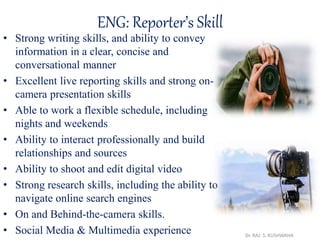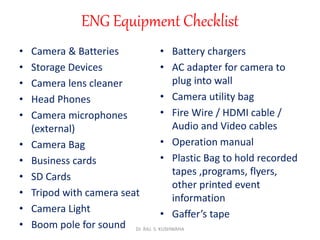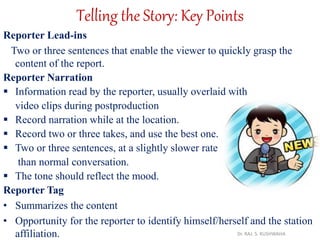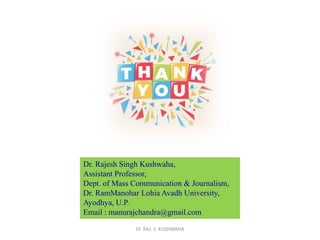Electronic News Gathering
- 1. Electronic News Gathering (ENG) Dr. Rajesh Singh Kushwaha, Assistant Professor, Dept. of Mass Communication & Journalism, Dr. RamManohar Lohia Avadh University, Ayodhya, U.P. Email : manurajchandra@gmail.com
- 2. Concept of ENG • The process of reporting events and activities that occur outside the television studio. • ENG is the term used for the technical production facilities required for outdoor productions. • In modern news operations, however, it also includes SNG (Satellite News Gathering) and DSNG (Digital Satellite News Gathering) Dr. RAJ. S. KUSHWAHA
- 3. Objective of ENG 1. Getting the story. 2. Visuals and Actuality 3. Making a News Story for a mass audience 4. Balance of News / The angle 5. Different Stroke/Treatment Dr. RAJ. S. KUSHWAHA
- 4. ENG: Reporter’s Skill • Strong writing skills, and ability to convey information in a clear, concise and conversational manner • Excellent live reporting skills and strong on- camera presentation skills • Able to work a flexible schedule, including nights and weekends • Ability to interact professionally and build relationships and sources • Ability to shoot and edit digital video • Strong research skills, including the ability to navigate online search engines • On and Behind-the-camera skills. • Social Media & Multimedia experience Dr. RAJ. S. KUSHWAHA
- 5. ENG: A Team Work • A successful ENG team produces a video segment that enables viewers to experience the event as if they were there. • The reporter and Cameraperson must be prepared for every situation that might present itself during the reporting of an event. • Library and internet resources to obtain background information on a larger scale . • Phone calls and face-to-face informal meetings to obtain background information. Dr. RAJ. S. KUSHWAHA
- 6. ENG Equipment • The camera is now the most powerful weapon in the world. Always check the camcorder and recording equipment before leaving the studio. Perform a Audio & Video check before leaving the studio. • Bring the microphones for various purpose. • POWER Supply: Charged batteries, Charger, Ac power supply, extra microphone batteries. Dr. RAJ. S. KUSHWAHA
- 7. ENG: basic Equipment • Storage Devices, tripod, headphones • Portable lighting Devices • Pen or pencil and paper for note taking. Dr. RAJ. S. KUSHWAHA
- 8. ENG Equipment Checklist • Camera & Batteries • Storage Devices • Camera lens cleaner • Head Phones • Camera microphones (external) • Camera Bag • Business cards • SD Cards • Tripod with camera seat • Camera Light • Boom pole for sound • Battery chargers • AC adapter for camera to plug into wall • Camera utility bag • Fire Wire / HDMI cable / Audio and Video cables • Operation manual • Plastic Bag to hold recorded tapes ,programs, flyers, other printed event information • Gaffer’s tape Dr. RAJ. S. KUSHWAHA
- 9. At the Scene… The Reporter… Talks with the organizer or supervisor of the event to obtain details. Talks to several people involved in the activity, and identifies potential interview guests. Prepares the script for lead- in, narration, and questions.Dr. RAJ. S. KUSHWAHA
- 10. at the Scene… The ENG Crew /The videographer… Prepares all equipment (camcorder, Storage devices, microphones, tripod, etc.) Starts videotaping activities, Discusses camera shots with the reporter, making sure to capture video covered by script. Dr. RAJ. S. KUSHWAHA
- 11. Recording the Story: Key Points Records several minutes of each activity as it occurs. Uses a variety of camera angles. Capture sounds of the event to use in the postproduction process. Records several “sound bites” to use during postproduction. Record “talking heads” with comments from participants. Record interviews. Dr. RAJ. S. KUSHWAHA
- 12. Telling the Story: Key Points Reporter Lead-ins Two or three sentences that enable the viewer to quickly grasp the content of the report. Reporter Narration Information read by the reporter, usually overlaid with video clips during postproduction Record narration while at the location. Record two or three takes, and use the best one. Two or three sentences, at a slightly slower rate than normal conversation. The tone should reflect the mood. Reporter Tag • Summarizes the content • Opportunity for the reporter to identify himself/herself and the station affiliation. Dr. RAJ. S. KUSHWAHA
- 13. Dr. Rajesh Singh Kushwaha, Assistant Professor, Dept. of Mass Communication & Journalism, Dr. RamManohar Lohia Avadh University, Ayodhya, U.P. Email : manurajchandra@gmail.com Dr. RAJ. S. KUSHWAHA












